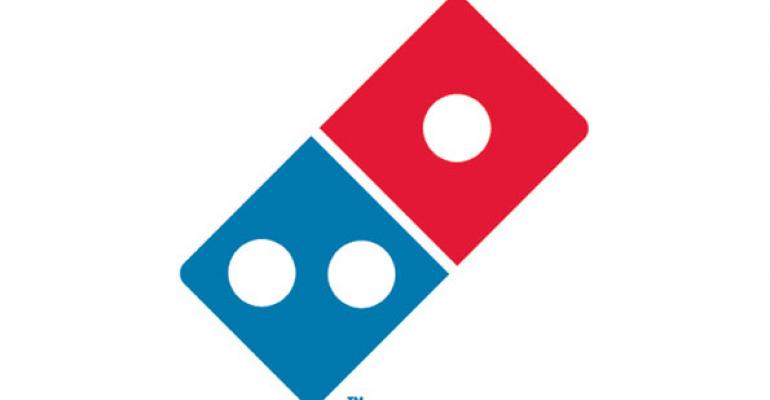Officials for Ann Arbor, Mich.-based Domino’s Pizza said the chain is leading the pizza category in same-store sales growth so far this year — due not to splashy new-product news but rather to steady messaging around value and its Handmade Pan Pizza, which launched last fall.
The company’s 6.7-percent increase in domestic same-store sales powered double-digit gains in revenue and net income in the June 16-ended second quarter. Domino’s consistent promotion of the new pan pizza and of deals around the $5.99 price point that have anchored its value proposition over the past few years is a sharp contrast to its largest competitor, Pizza Hut, whose leaders recently said they would shift advertising back toward steady value promotion.
RELATED
• Domino's Pizza 1Q profit leaps 66%
• Domino's Pizza to increase national ad spending
• Same-store sales at NRN.com
Aside from helping to produce robust traffic during the second quarter, continuity allows Domino’s corporate chefs to take their time developing and refining menu items that produce meaningful results and not rush products to market, chief executive Patrick Doyle said during the 10,440-unit chain’s earnings call.
“We’ve developed a bigger brand message around transparency and consumer engagement that we believe is carrying us to a different place,” Doyle said. “We believe this is part of why we don’t need constant new-pizza news or limited-time products to drive our business.”
Slicing up the competition
Domino’s second-quarter increase in same-store sales of 6.7 percent accelerated slightly from its 6.2-percent gain in the first quarter, when its Domino’s Dollars offer of a $5 online coupon gave way to another deal extending the chain’s $5.99 promotional price point to non-pizza items like sandwiches and chicken wings.
The chain has led its two main competitors in same-sales growth for the first half of the year.
So far in 2013, after finishing fiscal 2012 with a full-year same-store sales increase of 3 percent, Pizza Hut has reported comparable-sales decreases of 1 percent and 2 percent in the first and second quarters, respectively. The brand’s slow start could not be blamed on a lack of new-product introductions — Pizza Hut rolled out Big Pizza Sliders during February’s Super Bowl telecast and Firebaked-Style Flatbreads in mid-June, with a Crazy Cheesy Crust pizza limited-time offer and a $5.55 anniversary special offer in between.
During the second-quarter earnings call for Louisville, Ky.-based Yum! Brands Inc., Pizza Hut’s parent company, president Rick Carucci, admitted that Pizza Hut’s sales were “weak” and blamed inconsistent value messaging.
“In this environment, you win by delivering a consistent and compelling value message, and our competitors have simply done a better job in this area so far this year,” Carucci said. “We’ll have a more consistent value message going forward, and we continue to introduce new innovative products going forward, such as our flatbread pizza. We expect to deliver better sales growth at Pizza Hut for the balance of this year.”
Papa John’s Pizza is not scheduled to report second-quarter earnings until early August, but its first-quarter same-store sales gain of 1.6 percent was its smallest increase of the past four quarters.
Doyle acknowledged that Pizza Hut has been slightly negative for the year and that Papa John’s Pizza second-quarter results were unknown. However, he speculated that Domino’s market-share gains in the pizza segment this year likely would continue to come from small and regional players, which cannot keep pace with technology investments made by the national chains.
“There are some pretty special things that are going on with our brand and business right now that are causing us to grow a little faster even than our national peers,” Doyle said. “But overall, I think the basics of the thesis are intact, which is larger players are going to continue to take some share from the smaller players.”
Brand to build upon advantages
The major advantage Domino’s has over independent pizzerias and regional chains is its suite of online- and digital-ordering platforms, Doyle said, including a new app for Windows 8-enabled phones. Digital ordering accounts for nearly 40 percent of all transactions for Domino’s and has grown about 5 percent per year for many years, he added.
“I don’t see any reason why we’re not going to be able to get this number north of 50 percent over time,” he said. “And clearly, from our perspective, based on all the reasons … around ticket and order profitability and customer satisfaction, the faster we can push that, the better.”
Yet in second-quarter TV advertising, Domino’s took the opposite tack and emphasized the slow speed at which the Handmade Pan Pizza is made. The ad was a return to national TV for the new pan pizza, which was promoted heavily in the fourth quarter of 2012 with an introductory price point of $7.99 for a medium.
Domino’s de-emphasized the price in ads and came up with a new way to talk about the same premium-pizza product, Doyle said. The same thinking was in play during the first quarter, when the $5.99 price point of the past three years was reapplied to menu items beyond pizza.
“What we’ve been finding very effective is talking about the things that are differentiating the brands on an ongoing basis in the minds of the consumer,” Doyle said. The chain will continue to launch new products, he added, “but what we think is important is that we’re driving these results with bigger individual launches that are meaningfully changing consumers’ views about the quality of Domino’s Pizza, as opposed to simply creating new [products] for news’ sake."
Domino’s operates or franchises 4,932 restaurants in the United States and franchises 5,508 stores in more than 70 international markets. The company opened nine net new restaurants in the second quarter.
Contact Mark Brandau at [email protected].
Follow him on Twitter: @Mark_from_NRN





